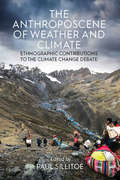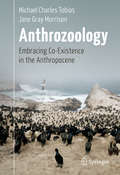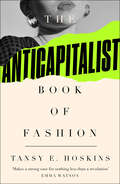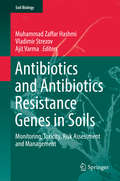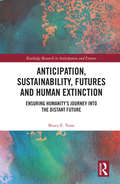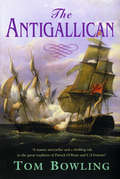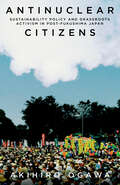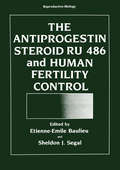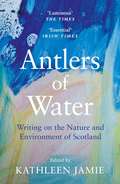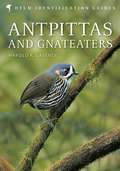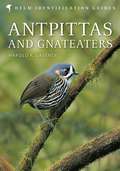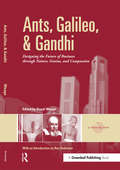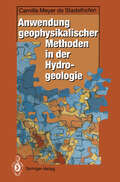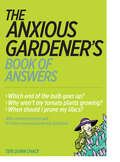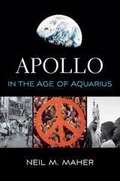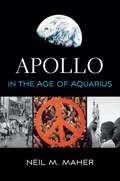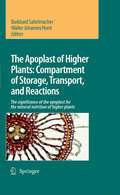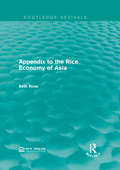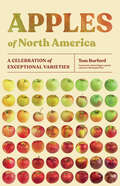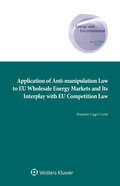- Table View
- List View
The Anthroposcene of Weather and Climate: Ethnographic Contributions to the Climate Change Debate
by Paul SillitoeWhile it is widely acknowledged that climate change is among the greatest global challenges of our times, it has local implications too. This volume forefronts these local issues, giving anthropology a voice in this great debate, which is otherwise dominated by natural scientists and policy makers. It shows what an ethnographic focus can offer in furthering our understanding of the lived realities of climate debates. Contributors from communities around the world discuss local knowledge of, and responses to, environmental changes that need to feature in scientifically framed policies regarding mitigation and adaptation measures if they are to be effective.
The Anthroposcene of Weather and Climate: Ethnographic Contributions to the Climate Change Debate
by Paul SillitoeWhile it is widely acknowledged that climate change is among the greatest global challenges of our times, it has local implications too. This volume forefronts these local issues, giving anthropology a voice in this great debate, which is otherwise dominated by natural scientists and policy makers. It shows what an ethnographic focus can offer in furthering our understanding of the lived realities of climate debates. Contributors from communities around the world discuss local knowledge of, and responses to, environmental changes that need to feature in scientifically framed policies regarding mitigation and adaptation measures if they are to be effective.
Anthrozoology: Embracing Co-Existence in the Anthropocene
by Michael Charles Tobias Jane Gray Morrison Bill GladstoneThis groundbreaking work of both theoretical and experiential thought by two leading ecological philosophers and animal liberation scientists ventures into a new frontier of applied ethical anthrozoological studies. Through lean and elegant text, readers will learn that human interconnections with other species and ecosystems are severely endangered precisely because we lack - by our evolutionary self-confidence - the very coherence that is everywhere around us abundantly demonstrated. What our species has deemed to be superior is, according to Tobias and Morrison, the cumulative result of a tragically tenuous argument predicated on the brink of our species’ self-destruction, giving rise to a most unique proposition: We either recognize the miracle of other sentient intelligence, sophistication, and genius, or risk enshrining the shortest lived epitaph of any known vertebrate in earth’s 4.1 billion years of life.Tobias and Morrison draw on 45 years of research in fields ranging from ecological anthropology, animal protection and comparative ethics to literature and spirituality - and beyond. They deploy research in animal and plant behavior, biocultural heritage contexts from every continent and they bring to bear a deeply metaphysical array of perspectives that set this book apart from any other. The book departs from most work in such fields as animal rights, ecological aesthetics, comparative ethology or traditional animal and plant behaviorist work, and yet it speaks to readers with an interest in those fields. A deeply provocative book of philosophical premises and hypotheses from two of the world’s most influential ecological philosophers, this text is likely to stir uneasiness and debate for many decades to come.
The Anti-Capitalist Book of Fashion
by Tansy E. Hoskins*Selected by Emma Watson for her Ultimate Book List* Fashion is political. From the red carpets of the Met Gala to online fast fashion, clothes tell a story of inequality, racism and climate crisis. In The Anti-Capitalist Book of Fashion, Tansy E. Hoskins unpicks the threads of capitalist industry to reveal the truth about our clothes. Fashion brands entice us to consume more by manipulating us to feel ugly, poor and worthless, sentiments that line the pockets of billionaires exploiting colonial supply chains. Garment workers on poverty pay risk their lives in dangerous factories, animals are tortured, fossil fuels extracted and toxic chemicals spread just to keep this season’s collections fresh. We can do better than this. Moving between Karl Lagerfeld and Karl Marx, The Anti-Capitalist Book of Fashion goes beyond ethical fashion and consumer responsibility showing that if we want to feel comfortable in our clothes, we need to reshape the system and ensure this is not our last season.
The Anti-Capitalist Book of Fashion
by Tansy E. Hoskins*Selected by Emma Watson for her Ultimate Book List* Fashion is political. From the red carpets of the Met Gala to online fast fashion, clothes tell a story of inequality, racism and climate crisis. In The Anti-Capitalist Book of Fashion, Tansy E. Hoskins unpicks the threads of capitalist industry to reveal the truth about our clothes. Fashion brands entice us to consume more by manipulating us to feel ugly, poor and worthless, sentiments that line the pockets of billionaires exploiting colonial supply chains. Garment workers on poverty pay risk their lives in dangerous factories, animals are tortured, fossil fuels extracted and toxic chemicals spread just to keep this season’s collections fresh. We can do better than this. Moving between Karl Lagerfeld and Karl Marx, The Anti-Capitalist Book of Fashion goes beyond ethical fashion and consumer responsibility showing that if we want to feel comfortable in our clothes, we need to reshape the system and ensure this is not our last season.
Antibiotics and Antibiotics Resistance Genes in Soils: Monitoring, Toxicity, Risk Assessment and Management (Soil Biology #51)
by Muhammad Zaffar Hashmi Vladimir Strezov Ajit VarmaThis book summarizes the current state of knowledge regarding antibiotics and antibiotics resistance genes (ARGs) in the soil environment. It covers a wide range of topics to help readers understand antibiotics and ARGs in soils, the risks they pose for the environment, and options for effective control. In addition, it presents a range of essential tools and methodologies that can be used to address antibiotics and ARGs in a consistent, efficient, and cost-effective manner.Gathering contributions by international experts, the book addresses both theoretical aspects and practical applications.The topics discussed include antibiotics-producing microorganisms; the routes of entry and fate of antibiotics and resistance genes; biomonitoring approaches; dissemination of ARGs in soils; risk assessment; the impact of antibiotics and ARGs on the soil microbial community and other biota; bioremediation and biodegradation approaches; and soil management strategies for antibiotics and ARG-contaminated soils.As such, the book will be of interest to students, researchers and scholars in environmental science and engineering, toxicology, the medical and pharmaceutical sciences, environmental biotechnology, soil sciences, microbial ecology and plant biotechnology.Readers and Journals:1. This new volume on antibiotics and antibiotics resistance genes (ARGs) in the soil environment will be of interest to students, researchers and scholars in environmental science and engineering, toxicology, the medical and pharmaceutical sciences, environmental biotechnology, soil sciences,microbial ecology and plant biotechnology.2. The book will provide government authorities all over the world with effective strategies for the management of antibiotics and antibiotics resistance genes (ARG)- contaminated soil. 3. Gathering contributions by international experts,the book addresses both theoretical aspects and practical applications.
Anticipation, Sustainability, Futures and Human Extinction: Ensuring Humanity’s Journey into The Distant Future (Routledge Research in Anticipation and Futures)
by Bruce E. TonnThis book considers the philosophical underpinnings, policy foundations, institutional innovations, and deep cultural changes needed to ensure that humanity has the best chance of surviving and flourishing into the very distant future. Anticipation of threats to the sustainability of human civilization needs to encompass time periods that span not just decades but millennia. All existential risks need to be jointly assessed, as opposed to addressing risks such as climate change and pandemics separately. Exploring the potential events that are likely to cause the biggest risks as well as asking why we should even desire to thrive into the distant future, this work looks at the ‘biggest picture possible’ in order to argue that futures-oriented decision-making ought to be a permanent aspect of human society and futures-oriented policy making must take precedent over the day-to-day policy making of current generations in times of great peril. The book concludes with a discourse on the truly fundamental bottom-up changes needed in our personal psychologies and culture to support these top-down recommendations. This book is of great interest to philosophers, policy analysts, political scientists, economists, psychologists, planners, and theologians.
Anticipation, Sustainability, Futures and Human Extinction: Ensuring Humanity’s Journey into The Distant Future (Routledge Research in Anticipation and Futures)
by Bruce E. TonnThis book considers the philosophical underpinnings, policy foundations, institutional innovations, and deep cultural changes needed to ensure that humanity has the best chance of surviving and flourishing into the very distant future. Anticipation of threats to the sustainability of human civilization needs to encompass time periods that span not just decades but millennia. All existential risks need to be jointly assessed, as opposed to addressing risks such as climate change and pandemics separately. Exploring the potential events that are likely to cause the biggest risks as well as asking why we should even desire to thrive into the distant future, this work looks at the ‘biggest picture possible’ in order to argue that futures-oriented decision-making ought to be a permanent aspect of human society and futures-oriented policy making must take precedent over the day-to-day policy making of current generations in times of great peril. The book concludes with a discourse on the truly fundamental bottom-up changes needed in our personal psychologies and culture to support these top-down recommendations. This book is of great interest to philosophers, policy analysts, political scientists, economists, psychologists, planners, and theologians.
The Antigallican
by Tom BowlingMay 1794. France is starving and a giant fleet prepares to run Lord Howe's blockade to bring corn from America to France. One of the escorts - The Hortense - finds Jersey born fishing captain, Jean Cotterell, alone in the sea off the Grand Banks. His fishing vessel has sunk and he is the sole survivor.Life on The Hortense is like France under the Terror; chaotic, ungovernable, savage. Her captain, Dubarre, a former privateer, seems to despise his revolutionary crew as much as he hates the British. On the Glorious 1st June 1794 Hortense is intercepted by two British frigates which smash her. Her officers are dead, her crew decimated, and a storm is brewing. Only Cotterell has the skill to lead the frigate to port. But will he do it? The Antigallican is the first in a series of novels set at the end of the 18th century at sea, in Britain, in the Channel Islands and in Revolutionary France. In Jean Cotterell we find a character that bears comparison with Bernard Cornwell's Sharpe, in a narrative that will delight fans of Patrick O'Brian. 'With its captivating, pungent, and sharply drawn characters, this first instalment in a series of sea stories is a welcome addition to the Napoleonic sea story genre' - Margaret Barr - Historical Novels Review' believe [Tom Bowling] has a great future, and will become one of the leading authors in the historical naval fiction genre' - Robert Squarebriggs
Antinuclear Citizens: Sustainability Policy and Grassroots Activism in Post-Fukushima Japan (Anthropology of Policy)
by Akihiro OgawaFollowing the Great East Japan Earthquake on March 11, 2011, tsunamis engulfed the Fukushima Daiichi nuclear power plant located on Japan's Pacific Coast, leading to the worst nuclear disaster the world has seen since the Chernobyl crisis of 1986. Prior to this disaster, Japan had the third largest commercial nuclear program in the world, surpassed only by those in the United States and France—nuclear power significantly contributed to Japan's economic prosperity, and nearly 30% of Japan's electricity was generated by reactors dotted across the archipelago, from northern Hokkaido to southern Kyushu. This long period of institutional stasis was, however, punctuated by the crisis of March 11, which became a critical juncture for Japanese nuclear policymaking. As Akihiro Ogawa argues, the primary agent for this change is what he calls "antinuclear citizens"— a conscientious Japanese public who envision a sustainable life in a nuclear-free society. Drawing on over a decade of ethnographic research conducted across Japan—including antinuclear rallies, meetings with bureaucrats, and at renewable energy production sites—Ogawa presents an historical record of ordinary people's actions as they sought to survive and navigate a new reality post-Fukushima. Ultimately, Ogawa argues that effective sustainability efforts require collaborations that are grounded in civil society and challenge hegemonic ideology, efforts that reimagine societies and landscapes—especially those dominated by industrial capitalism—to help build a productive symbiosis between industry and sustainability.
Antinuclear Citizens: Sustainability Policy and Grassroots Activism in Post-Fukushima Japan (Anthropology of Policy)
by Akihiro OgawaFollowing the Great East Japan Earthquake on March 11, 2011, tsunamis engulfed the Fukushima Daiichi nuclear power plant located on Japan's Pacific Coast, leading to the worst nuclear disaster the world has seen since the Chernobyl crisis of 1986. Prior to this disaster, Japan had the third largest commercial nuclear program in the world, surpassed only by those in the United States and France—nuclear power significantly contributed to Japan's economic prosperity, and nearly 30% of Japan's electricity was generated by reactors dotted across the archipelago, from northern Hokkaido to southern Kyushu. This long period of institutional stasis was, however, punctuated by the crisis of March 11, which became a critical juncture for Japanese nuclear policymaking. As Akihiro Ogawa argues, the primary agent for this change is what he calls "antinuclear citizens"— a conscientious Japanese public who envision a sustainable life in a nuclear-free society. Drawing on over a decade of ethnographic research conducted across Japan—including antinuclear rallies, meetings with bureaucrats, and at renewable energy production sites—Ogawa presents an historical record of ordinary people's actions as they sought to survive and navigate a new reality post-Fukushima. Ultimately, Ogawa argues that effective sustainability efforts require collaborations that are grounded in civil society and challenge hegemonic ideology, efforts that reimagine societies and landscapes—especially those dominated by industrial capitalism—to help build a productive symbiosis between industry and sustainability.
The Antiprogestin Steroid RU 486 and Human Fertility Control (Reproductive Biology)
by Etienne-Emile BaulieuAdvances in basic biological research have proceeded rapidly in recent years. The fields of molecular genetics and immunology have experienced dramatic breakthroughs, capturing the imagination of both the scientific community and the general public. With less public notice, receptor biology has brought a cascade of new discoveries and insights. The entire science of pharmacology has been virtually rewritten in terms of receptor phenomenology. In particular, the discovery of specific receptors for steroid and protein hormones has been of seminal importance. With this new information, we have advanced our understanding of the mechanism and specifity of hormone action. We can now explain how hormones interact selectively with specific target cells and how hormones alter biochemical events within the target cells. These facts have already impacted on applied problems of clinical medicine, particularly in diagnosis and treatment of cancer and some metabolic diseases. Now, a new and important application of basic receptor biology and chemistry looms ahead. Within a few short years since the discovery of the progesterone receptor, chemists have synthesized molecules with a greater affinity for the receptor than progesterone itself and which, while occupying the receptor, fail to trigger the events which transform a target cell from the unstimulated to the stimulated state. This is the basis of the competitive inhibitory action of the anti-progestational agent, synthesized by the chemists at Roussel Uc1af, Paris, and designated RU 486.
Antlers of Water: Writing on the Nature and Environment of Scotland
by Kathleen Jamie'Luminous' The Times 'Beautiful’ Caught by the River Bringing together contemporary Scottish writing on nature and landscape, this inspiring collection takes us from walking to wild swimming, from red deer to pigeons and wasps, from remote islands to back gardens, through prose, poetry and photography. Edited and introduced by Kathleen Jamie, and with contributions from Amy Liptrot, Jim Crumley, Chitra Ramaswamy, Malachy Tallack, Amanda Thomson and many more, Antlers of Water urges us to renegotiate our relationship with the more-than-human world, in writing which is by turns celebratory, radical and political.
Antpittas and Gnateaters
by Harold Greeney David BeadleElusive study organisms for ornithologists and highly prized additions to the birder's life-list, the antpittas (Grallariidae) and gnateaters (Conopophagidae) are among the most poorly known Neotropical bird groups. This authoritative handbook is the first book dedicated solely to these two families, combining an exhaustive review of more than two centuries of literature with original observations by the author and many knowledgeable contributors. Antpittas and Gnateaters provides a thorough guide to the identification and ecology of these birds, with detailed maps accompanying the text. A series of superb plates illustrate most of the 156 recognized taxa; supplemented by more than 250 colour photographs, the immature plumages and natural history of many species are depicted for the first time. This book is the ultimate reference on these remarkable and beautiful birds, and an indispensible addition to the libraries of researchers and birders for many years to come.
Antpittas and Gnateaters
by Harold Greeney David BeadleElusive study organisms for ornithologists and highly prized additions to the birder's life-list, the antpittas (Grallariidae) and gnateaters (Conopophagidae) are among the most poorly known Neotropical bird groups. This authoritative handbook is the first book dedicated solely to these two families, combining an exhaustive review of more than two centuries of literature with original observations by the author and many knowledgeable contributors. Antpittas and Gnateaters provides a thorough guide to the identification and ecology of these birds, with detailed maps accompanying the text. A series of superb plates illustrate most of the 156 recognized taxa; supplemented by more than 250 colour photographs, the immature plumages and natural history of many species are depicted for the first time. This book is the ultimate reference on these remarkable and beautiful birds, and an indispensible addition to the libraries of researchers and birders for many years to come.
Ants, Galileo, and Gandhi: Designing the Future of Business through Nature, Genius, and Compassion
by Sissel Waage Ray AndersonAlthough sustainability efforts in business are still a work in progress, it is increasingly clear that key elements of a new generation of enterprises will be radically different from those of our contemporary modern industrial economy. The core distinctions between what currently exists and what is being created are communicated in this book through the compelling metaphor of Ants, Galileo, and Gandhi. This collection, developed from The Natural Step's conference on Sustainability and Innovation in 2002, provides radical ideas for generating a new perspective on the dynamics of business systems. "Ants" symbolise the lessons to be learned from nature and the dependence of individual beings on broader, complex systems. "Galileo" embodies brilliance in perceiving and proving that the current paradigm is flawed. 'Gandhi' exemplifies exceptional compassion in fighting for fundamental change. All of these attributes are increasingly relevant in a world where, globally, we are experiencing both a steady decline in life-supporting resources and rising demands. Recognition of these challenges is sparking innovation within the private sector where the first glimmers of systemic change can be seen. The book examines the emergence of 21st-century enterprises that recognise their reliance on broad social and ecological systems ("ants"), incorporate sparks of genius rooted in rigorous analyses ("Galileo"), and acknowledge the importance of compassion and determination within any endeavour ("Gandhi"). With contributions from Ray Anderson, Gretchen Daily, Karl-Henrik Rob
The Anxious Gardener's Book of Answers
by Teri Dunn ChaceThe Anxious Gardener's Book of Answers identifies the 100 most common gardening mistakes and gives gardeners the techniques to prevent them. Or, if it's too late and they've already goofed, there are tips to fix the mistake. The book's 24 chapters tackle every kind of gardening disaster, whether it has to do with plants, tools and techniques, or general care and maintenance. Gardeners looking to prune their roses will learn to hold off until late winter to avoid damaging plant tissue. Gardeners that have allowed their mint to overgrow? Dunn advises pulling it out and replanting it in a container to control the root. Organized by common garden topics and designed to be easily dipped in and out of, The Anxious Gardener's Book of Answers offers nuggets of wisdom based on Teri Dunn Chace's years of hands-on gardening experience. Advice is humorously supported by Colleen Coover's delightful illustrations. This accessible guide will transform an anxious gardener into an informed, confident, successful gardener with a mistake-free garden
Apollo in the Age of Aquarius
by Neil M. MaherIn summer 1969, astronauts landed on the moon and hippie hordes descended on Woodstock—two era-defining events that are not entirely coincidental. Neil M. Maher shows how NASA’s celestial aspirations were tethered to terrestrial concerns of the time: the civil rights struggle, the antiwar movement, environmentalism, feminism, and the culture wars.
Apollo in the Age of Aquarius
by Neil M. MaherIn summer 1969, astronauts landed on the moon and hippie hordes descended on Woodstock—two era-defining events that are not entirely coincidental. Neil M. Maher shows how NASA’s celestial aspirations were tethered to terrestrial concerns of the time: the civil rights struggle, the antiwar movement, environmentalism, feminism, and the culture wars.
The Apoplast of Higher Plants: The significance of the apoplast for the mineral nutrition of higher plants
by Burkhard Sattelmacher Walter J. HorstThis book summarizes the experimental work conducted during a trans-disciplinary research program conducted for six years by the German Research Foundation. Each chapter includes introductory remarks written by internationally recognized scientists in their research areas. Contributiing authors representing outstanding German scientists from such different disciplines as Physics, Biochemistry, Plant Nutrition, Botany, and Molecular Biology not only report original research but also review the state of knowledge in their fields of research.
Appendix to the Rice Economy of Asia (Routledge Revivals)
by Beth RoseOriginally published in 1985, Beth Rose’s Appendix to the Rice Economy of Asia provides twenty-six tables detailing various rice statistics across Asia from the beginning of the twentieth century through to the 1980’s. Statistics presented include; total crop area, rice production and yield, import and export, rice prices, farm wages and populations of countries or areas within Asia. This title will be of interest to students of Environmental Studies and Economics.
Appendix to the Rice Economy of Asia (Routledge Revivals)
by Beth RoseOriginally published in 1985, Beth Rose’s Appendix to the Rice Economy of Asia provides twenty-six tables detailing various rice statistics across Asia from the beginning of the twentieth century through to the 1980’s. Statistics presented include; total crop area, rice production and yield, import and export, rice prices, farm wages and populations of countries or areas within Asia. This title will be of interest to students of Environmental Studies and Economics.
Apples of North America: A Celebration of Exceptional Varieties
by Tom BurfordThis celebration of apples will encourage readers to seek out new flavors, discover tasty methods of preservation, and maybe even try to grow their own at home.
Application of Anti-manipulation Law to EU Wholesale Energy Markets and Its Interplay with EU Competition Law (Energy and Environmental Law and Policy Series)
by Huseyin Cagri CorluIn the course of energy liberalisation, electricity and natural gas contracts have been separated from physical delivery, and these contracts are now traded as commodities in multilateral trading facilities. Although designed to render energy trading standardised and efficient, this system raises serious questions as to whether existing regulatory and antitrust provisions are sufficient to address market abuses that cause imbalances in demand and supply. The European Union’s (EU’s) Regulation on Wholesale Energy Market Integrity and Transparency (REMIT), adopted to combat such market manipulation, is still lacking in significant case law to bolster its effectiveness. Addressing this gap, this invaluable book provides the first in-depth analysis of market manipulation in the energy sector, offering a deeply informed understanding of the new anti-manipulation rules and their implementation and enforcement. Focusing on practices that perpetrators employ to manipulate electricity and natural gas markets and the applicability of anti-manipulation rules to combat such practices, the analysis examines such issues and topics as the following: – factors and circumstances that determine when and what market misconduct can be subject to enforcement; – the European Commission’s criteria to determine whether a particular market is susceptible to regulation; – jurisdiction of REMIT and the Market Abuse Regulation (MAR) with respect to the prohibitions of insider trading in financial wholesale energy markets; – to what extent anti-manipulation rules and EU competition law may be applied concurrently; and – types of physical and financial instruments that market participants have employed in devising their manipulative schemes. Because market manipulation is rather new in the EU context but has been prohibited and prosecuted under US law for over a century, much of the case law analysis is from the United States and greatly clarifies how anti-manipulation rules may be enforced. A concluding chapter offers policy recommendations to mitigate legal uncertainties arising from REMIT. Energy market participants, such as energy producers, wholesale suppliers, traders, transmission system operators and their counsel, and legal practitioners in the field will welcome this book’s extensive legal analysis and its clear demarcation of the objectives that REMIT seeks to accomplish with respect to energy market liberalisation.
